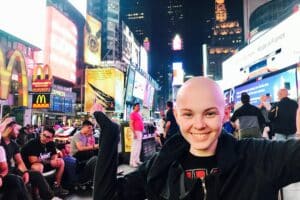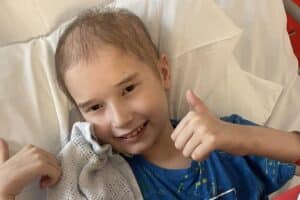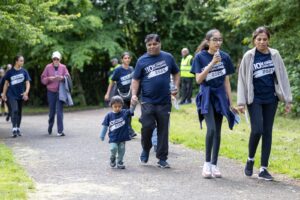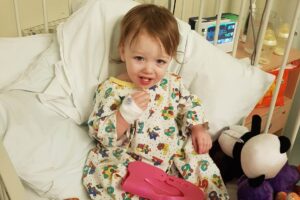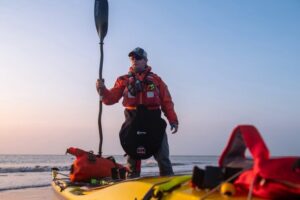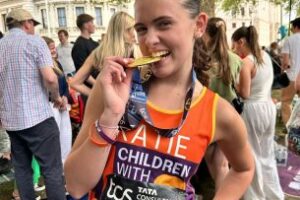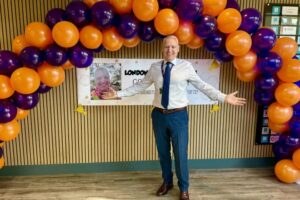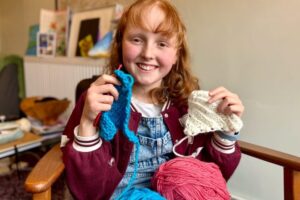George’s Rhabdomyosarcoma Story
George was diagnosed with rhabdomyosarcoma on 3 August 2023 when he was just two years old. His dad Jonathan tells their story so far: Support children like George so that they have a future they deserve.
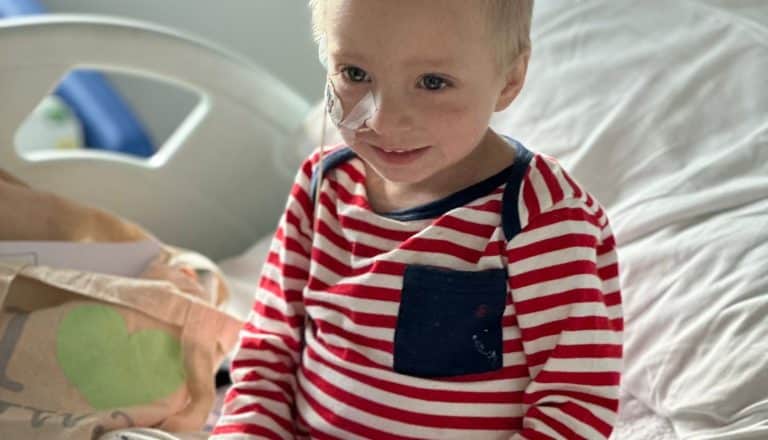
Early signs
George had just turned two when he became unwell, two months before the diagnosis of rhabdomyosarcoma. It became apparent he had an obstruction in his liver and bile duct as he became increasingly jaundiced. We were in and out of hospitals and finally, within 48 hours, a biopsy was undertaken. Then, we heard the unthinkable news. I remember the moment with extreme clarity – it felt like my entire world had collapsed.
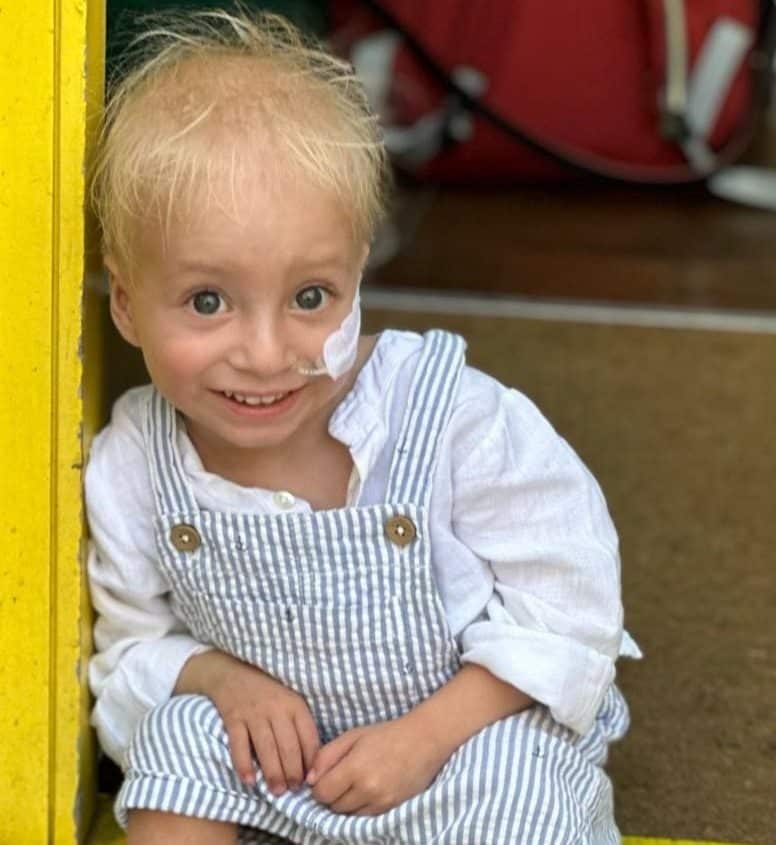
Treatment begins
A few deep breaths and the typically English cup of tea did little to improve the outlook. However, as I have often found in life, the right people often ‘appear’ in your life and come to your rescue. This was no exception. Within hours, we were whisked off to the children’s hospital to begin chemotherapy. The medical pathway seemed straightforward at first glance. We were put on the CVA chemotherapy plan (cyclophosphamide, vincristine, actinomycin-D). This involved nine rounds of chemotherapy with planned reviews (scans) every three rounds and a probable operation (resection) after the first scan.
Within hours we were whisked off to the children’s hospital
First scan results
After three rounds of chemotherapy, we went for our first scan. The feedback was limited but worrying – apparently, no shrinkage of the tumour. This was our first wake-up call. We received only very vague updates from the hospital. Shrinking the tumour was crucial for planning the resection. Unsatisfied, we sought a private review. Within a few days, we had a detailed review of the imaging, which showed that the tumour was indeed shrinking – this was the news we needed to hear.
This was our first wake-up call
Genetic complications
Shrinking the tumour was imperative to enable resection. The main problem was ‘where’ the tumour was located. It was in the middle of the liver and the main bile duct. Removing the left side of the liver was possible, but there needed to be shrinkage to ensure the right side of the liver remained clear of the tumour post-operation. The situation became more complex when we received the results of a whole genome sequencing test on George. It showed he had two very rare genetic conditions, Silver Russell Syndrome and Mosaic Variegated Aneuploidy (MVA) Syndrome, which has an underlying risk of causing cancers – which seemed to be the case for George.
It showed he had two very rare genetic conditions
Seeking second opinions
We continued with the children’s hospital for chemotherapy. After another three rounds and another scan, the hospital still reported no shrinkage (though our private radiologist disagreed). This prompted the hospital to seek second opinions for RMS patients like George. This unearthed a White Paper from a hospital in Paris, which reviewed 30 children over about 10 years with RMS of the liver and bile duct. It was difficult to draw many trends from the small data set, but it was encouraging to learn that 70-80 percent of children with a tumour similar to George’s survived beyond the five-year point and many went on to live long and healthy lives (although none had MVA like George).
The hospital still reported no shrinkage
Consulting world experts
We also began seeking second opinions from world-leading experts in paediatric liver and bile duct RMS patients. Professor Anil Dhawan, who heads an amazing paediatric liver team and the children’s ward, was instrumental in helping us. With his help, we lined up consultations with experts from Taiwan, USA, India, Russia (proton beam therapy), Germany (radio-pharma), France, and London. His energy, positivity, and network helped us have meaningful conversations with the right people and begin to formulate a plan. This culminated in a visit to Paris to meet the team who produced the White Paper.
We also began seeking second opinions
Continued treatment
The result was a plan to finish the last three rounds of chemotherapy and then undertake a ground-breaking procedure for George. This involved a two-stage operation. Firstly, to use Nano Knife Technology (IRE) on the tumour and surrounding area of the liver. This would give the surgeons a better margin of clearance around the tumour for the resection, ensuring the right side of the liver remained clear of the tumour.
And then undertake a ground-breaking procedure
Successful Operation
On Tuesday 12 March, George underwent his operation at the children’s hospital. We waited anxiously for the results and were quickly told that everything went according to plan. Amazingly, the two-stage procedure had been a success. The surgeons managed to remove all the tumour and had clear margins all the way around the removed section of his liver. This is what we had all been hoping and praying for.
This is what we had all been hoping and praying for
Recovery and moving forward
George remained in ICU for a week, followed by HDU for another week. When we got him back to the main children’s ward, his weight had dropped to 7.2kg. But we had got him through the process and the road to recovery could begin. To date, George is the youngest patient in the world to have received Nano Knife Technology and is the first paediatric patient to receive such treatment on his liver in the UK.
George is the youngest patient in the world to have received this
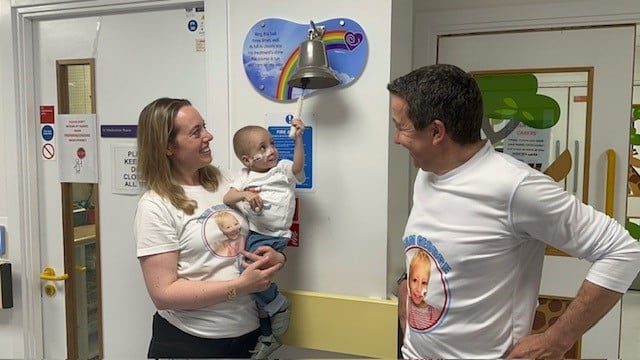
Extreme gratitude
There are too many people to thank individually, but two people have stood out for us. Consultant Sharon Jeetha has remained by our side throughout this journey. Secondly, Professor Anil Dhawan has been the best advocate we could have asked for in pulling together the best team and innovative treatment plan to get George successfully through this operation. We cannot thank them both enough. At the moment, we are glad to say that George remains fit and healthy.
If you’d like to hear more about our family and Team George’s last 12 months then we’d love you to watch our video here.
Jonathan, George’s dad, July 2024
Update: January 2025
George is doing great. He has been spending time with his grandparents, going to nursery and having play dates. George had a great Christmas and went to the London aquarium, which he loved.
Jonathan, George’s dad, January 2025.
How you can help
If you’ve been touched by George’s journey, help us invest in the high quality research that really matters which would otherwise go unfunded. This helps to support children with cancer so they can be with their families for longer
Have you or a family member been affected by childhood cancer?
Many of our supporters have been affected by childhood cancer – either through family, friends or their own personal experience. These patient stories can help inspire others to get involved with us, or can support our media work. If you have a story that you would like to tell,
Other stories
We have lots of information to help you learn more about childhood cancer. From specific cancer types, to treatments and causes.


